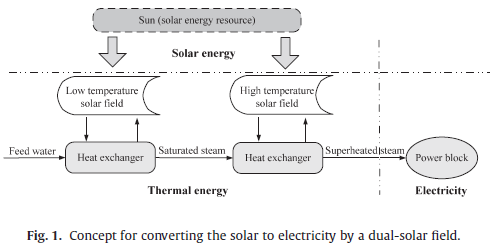In this paper, a new parabolic trough solar power system that incorporates a dual-solar field with oil and molten salt as heat transfer fluids (HTFs) is proposed to effectively utilize the solar energy. The oil is chosen as a HTF in the low temperature solar field to heat the feeding water, and the high temperature solar field uses molten salt to superheat the steam that the temperature is higher than 773 K. The produced superheated steam enters a steam turbine to generate power. Energy analysis and exergy analysis of the system are implemented to evaluate the feasibility of the proposed system. Under considerations of variations of solar irradiation, the on design and off-design thermodynamic performances of the system and the characteristics are investigated. The annual average solar-to-electric efficiency and the nominal efficiency under the given condition for the proposed solar thermal power generation system reach to 15.86% and 22.80%, which are higher than the reference system with a single HTF. The exergy losses within the solar heat transfer process of the proposed system are reduced by 7.8% and 45.23% compared with the solar power thermal systems using oil and molten salt as HTFs, respectively. The integrated approach with oil and molten salt as HTFs can make full use of the different physical properties of the HTFs, and optimize the heat transfer process between the HTFs and the water/steam. The exergy loss in the water evaporation and superheated process are reduced, the system efficiency and the economic performance are improved. The research findings provide a new approach for the improvement of the performances of solar thermal power plants.
Conclusions
In this work, we propose a solar thermal power system that incorporates a dual-solar field with oil and molten salt as HTFs to utilize solar energy, the system thermodynamic and preliminary economic performances are investigated, and the main research findings can be outlined as follows:
(1) With the assistance of molten salt, the primary steam temperature of the proposed OIL–MS system can be increased to 773 K by a two-stage heating process. The net solar-to-electric efficiency under the on-design condition reaches 22.80%, and the irreversible loss within the HTF–steam heat transfer process is reduced by 7.8% compared with that of the OIL system.
(2) Since about 72.02% of the required solar thermal energy in the OIL–MS system is collected by the low temperature field, the proposed dual-solar field can be operated annually with a higher efficiency, system performances under the off design conditions are improved, and the annual net solar-to-electric efficiency reaches 15.86%.
(3) The developed OIL–MS system benefits from the improved thermodynamic performances and the lower capital cost of the OIL–MS system, and the annual electricity generation cost is reduced to 0.142 €/kW・h.
It is worth mentioning that the dual-solar field concept, with oil and molten salt as HTFs in the parabolic trough solar power system, exhibits favorable thermodynamic and economic performances, and it provides a promising approach for the efficient utilization of solar energy.
The results have been published on Applied Thermal Engineering 93 (2016) 967–977.
